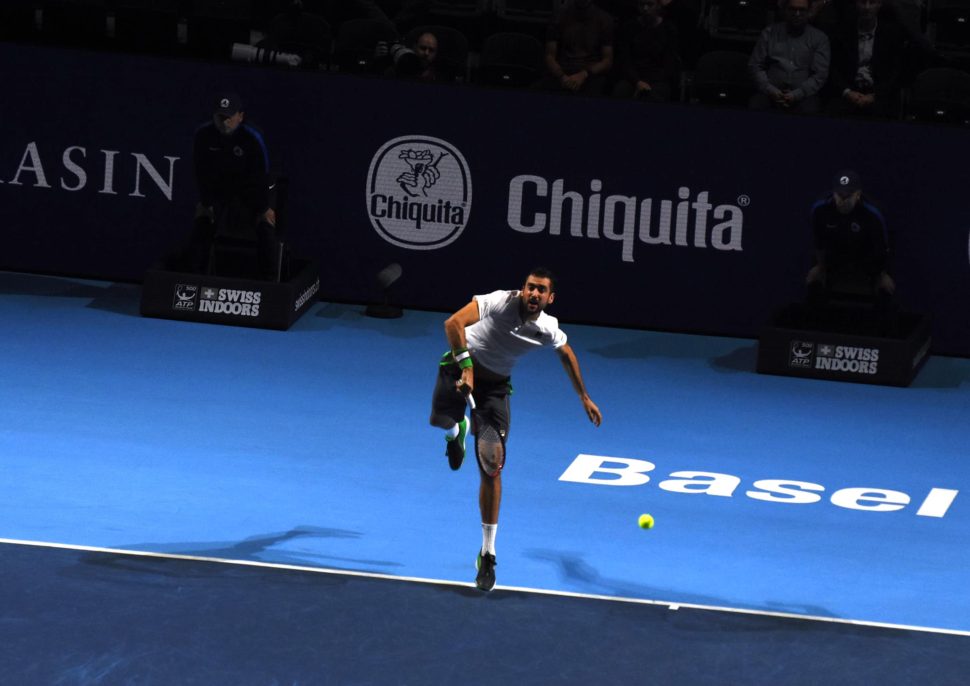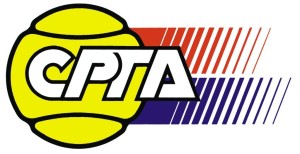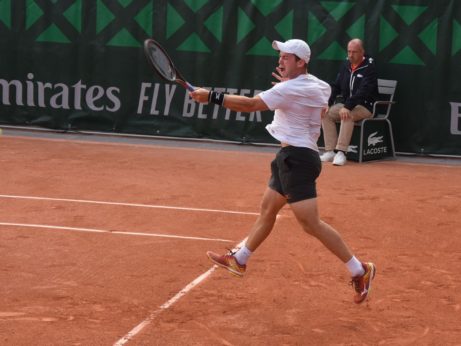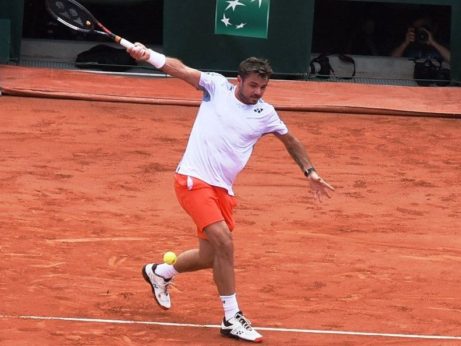Marin Cilic – Potential risk factors in his service

Tall Marin Cilic (*1988 / CRO) belongs not only because of his impressive 198 cm (6’6”) build to the better servers on the ATP Tour. His service (obviously a clear Service 3.0) has also some excellent technical qualities, mainly around the quite often almost perfect pronation. Despite that, a deeper look at the stats shows that Marin’s service, for some probably quite surprisingly, doesn’t have the efficiency of the very best in the business. In my personal opinion, Marin’s relatively limited service reliability was, over the years, the main reason for some of his tough loses in tight matches, like to Guido Pella (ARG) in the 2nd round of the 2018 Wimbledon, to Kei Nishikori (JPN) in the quarterfinals of the 2018 US Open or to Marin Copil (ROM) in the 2nd round of the 2018 Swiss Indoors, to name just some from the current year. This relative weakness, when compared to his very best peers, might have cost him quite a few titles and quite some millions on prize-money over the years.
Over his entire ATP Tour career, Cilic has just 56% of the 1st services in the game, in comparison Djokovic 65%, Nadal 69%, Federer 62%, Del Potro 64%, A. Zverev 63%, Anderson 65%, Raonic 63%, Isner 69%, Thiem 59%, Nishikori 61%, Khachanov 60%, Coric 62%, Fognini 59%, Edmund 59%, Tsitsipas 58%, Kyrgios 65%, Murray 58%, Wawrinka 58%, Sampras 59%, Copil 57%, Becker 57%, Muller 61 %, Karlovic 66% – so all the current (and also the here mentioned former) top 10 players and even some of the players (still) ranked quite far behind Cilic have a higher 1st service percentage than him. Cilic then makes a bit up for that by winning a very solid 77% of the points while his 1st service went in (Karlovic 83%, Raonic 81%, Sampras 81%, Becker 79%, Isner 78%, Muller 78%, Anderson 77%, Federer 77%, Kyrgios 77%, Copil 75%, Tsitsipas 75%, Murray 74%, Del Potro 74%, Thiem 74%, Djokovic 73%, A. Zverev 73%, Wawrinka 73%, Nadal 72%).
Also in the percentage of the points won on the 2nd service is Cilic with his 53% behind the best – Federer 57%, Nadal 57%, Isner 56%, Djokovic 55%, Raonic 55%, Wawrinka 54%, Kyrgios 54%, tied with him at 53% are Sampras, Karlovic, Del Potro, Anderson, Coric, Tsitsipas, Thiem, Nishikori, slightly lower at 52% are Murray and Copil, A.Zverev 51%, Becker 50%.
Besides the above-mentioned stats, Cilic has a 22 % double-fault probability and a 71% ace probability per service game. Also here, he is behind the best servers (Karlovic has a 142% ace probability per service game, Isner 125%, Raonic 115%, Kyrgios 107%, Muller 103%, Anderson 95%, Copil 88%), from whom Raonic, Kyrgios, Muller as well as Copil are a bit of smaller body size (shorter) than Cilic and still serve the 1st service mostly faster than him.
In the percentage of all the service points won comes Cilic to 66%, in comparison Karlovic 73%, Isner 71%, Raonic 71%, Federer 70%, Sampras 69%, Kyrgios 69%, Anderson 68%, Djokovic 67%, Nadal 67%, Del Potro 67%, Becker 67%, Muller 67%, Tsitsipas 66%, Thiem 66%, Copil 66%, Khachanov 66%, Fognini 66%, Murray 65%, A. Zverev 65%, Wawrinka 65%, Nishikori 64%, etc.)
The above-mentioned stats then translate into the almost all deciding bottom line, the percentage of the service games won, and also here is Marin Cilic with his 84% not among the very best – Karlovic 92%, Isner 92%, Raonic 91%, Federer 89%, Sampras 89%, Kyrgios 88%, Anderson 87%, Djokovic 86%, Nadal 86%, Becker 86%, Del Potro 85%, Muller 85%, Tsitsipas 84%, Copil 83%, Thiem 83%, Murray 82%, Wawrinka 82%, A. Zverev 82%, Nishikori 81%.
Needless to say, these official ATP Tour statistics are for the entire ATP Tour career of each player (or since the data collection started – Sampras, Becker) as of the end of November 2018. Based on this, the mostly less glorious beginning/finding years on the ATP Tour are typically putting the statistics more down for the younger players like Alexander Zverev (*1997 / GER) who haven’t been around for that long yet. In this regard is then quite remarkable, how far up in many of the statistics is Stefanos Tsitsipas (*1998 / GRE) already, the youngest of all the players mentioned here. When we look at the new ATP Tour metric aka Serve Leaders© in their Serve Rating© just for the year 2018, Cilic is at #11. In general, while combining both career and the 2018 statistics, the extremely tall players (Karlovic, Isner, Anderson – all over 200cm / 6’7”) are clearly ahead. Quite tall Cilic (198cm / 6’6”) is then ranked with most of his service statistics behind some players of the same size (like Del Potro) and also behind the players of slightly (Raonic, Kyrgios) or even significantly “smaller” size (Federer, Nadal, Djokovic, Copil, Muller). From the current (or recent former) top players with at least 3 years in the top 10, only the relatively “bad servers” Murray, Wawrinka (mainly because of his past) as well as Nishikori, all with some technical challenges in their services limiting the speed and/or the margin (Wawrinka), are behind him. This all must lead to the conclusion that something is holding Cilic’s service down a bit.
In general, the reasons might be either in the mental or in the technical area and needless to say, these two can be often very closely connected, as they are probably also in Cilic’s case. From my personal point of view, the main risk factor (weak spot) in Marin’s service is the unstable position of his tossing (left) arm after the ball release and mainly while he pulls it down. Practically all the best servers in the history, as well as all current dominant servers on the ATP Tour, are pulling the tossing arm down in a way that the arm (elbow/hand) stops and stays at their body (chest or belly) for a moment and is thus “hard-stopping” the non-dominant shoulder. Such well-timed non-dominant shoulder stop then ideally leads to an optimal dominant shoulder/arm action (based on the action-reaction forces aka 3rd Newton’s Law) as well as to its optimal position in the space and thus to an optimal body energy unloading into the dominant (hitting) arm. Marin’s tossing (left) arm/elbow stays often away from the body (torso) after being pulled down and then goes quite soon into a massive throw-back. This, while causing rather slightly lower position and mainly faster falling down of the hitting shoulder/elbow (limited shoulder over shoulder position, disturbed stroke axis), leads, in my opinion, to both, a certain deficiency in the optimal body energy unloading as well as to a less perfect racket control in the space (limited helix effect based on unstable helix axis). Translated into the outcome, it means slightly less speed and a certain reduction in the precision.

Marin Cilic (*1988 / CRO) – even in the winning 4th set of the quarterfinals match lost to Kei Nishikori (JPN) in 5 sets, his 1st service was at 58% only – Maric lost the match even though “winning 152-144 on the points played” – 2018 US Open – New York / USA – September 2018

Marin Cilic (*1988 / CRO) – 1st service 3.0 in a match – deuce side – 1 of 6 – start – rather a bit clumsy-looking wide platform stance, also interestingly bend wrist of the tossing arm – 2018 US Open – New York / USA – September 2018

Marin Cilic (*1988 / CRO) – 1st service 3.0 in a match – deuce side – 2 of 6 – toss / loading – tossing (left) arm travels quite early after the ball release to the left side – 2018 US Open – New York / USA – September 2018

Marin Cilic (*1988 / CRO) – 1st service 3.0 in a match – deuce side – 3 of 6 – push-off – initiation from the platform stance – 2018 US Open – New York / USA – September 2018

Marin Cilic (*1988 / CRO) – 1st service 3.0 in a match – deuce side – 4 of 6 – acceleration from the cocking position – tossing (left) arm/hand are rather away from the body – 2018 US Open – New York / USA – September 2018

Marin Cilic (*1988 / CRO) – 1st service 3.0 in a match – deuce side – 5 of 6 – follow through 1 aka targeted long-axis pronation – end – tossing (left) elbow seems to be “free-floating” very early, the hitting arm, despite almost perfect pronation, seems to be falling down a bit too early – 2018 US Open – New York / USA – September 2018

Marin Cilic (*1988 / CRO) – 1st service 3.0 in a match – deuce side – 6 of 6 – landing / follow through 2 aka relaxation – quite massing tossing (left) arm throw-back – 2018 US Open – New York / USA – September 2018

Marin Cilic (*1988 / CRO) – 1st service 3.0 in a match – deuce side – 1 of 3 – toss – short before the ball release – wide platform base – 2018 Swiss Indoors – Basel / Switzerland – October 2018

Marin Cilic (*1988 / CRO) – 1st service 3.0 in a match – deuce side – 2 of 3 – just before the impact – perfect eye control, but the tossing (left) arm doesn’t seem to be making it to a stop at the body – 2018 Swiss Indoors – Basel / Switzerland – October 2018

Marin Cilic (*1988 / CRO) – 1st service 3.0 in a match – deuce side – 3 of 3 – follow through 1 – targeted long-axis pronation – slightly unstable – early tossing (left) arm throw-back lets fall the hitting (right) arm down rather a bit too early, the stroke axis seems to be a bit unstable – 2018 Swiss Indoors – Basel / Switzerland – October 2018

Marin Cilic (*1988 / CRO) – 2nd spin service 3.0 in a match – deuce side – 1 of 2 – shortly after the impact – rather an unstable tossing (left) arm position in the space – 2018 Swiss Indoors – Basel / Switzerland – October 2018

Marin Cilic (*1988 / CRO) – 2nd spin service 3.0 in a match – deuce side – 2 of 2 – follow through 1 – end – massive throw-back of the tossing (left) arm seems to limit the optimal body energy unloading in both the qualitative as well as the quantitative way – 2018 Swiss Indoors – Basel / Switzerland – October 2018
For comparison, let’s look at Marius Copil (ROM) in their 2nd round Basel match, which Copil won 7/5 7/6 while serving the 1st services mostly around 10% faster than Cilic. In this particular match, Cilic had just 39%!!! of the 1st services in while winning 76% of them. Copil had 55% of the 1st services in and won 90% 0f them!!
Marius Copil (*1990 / ROM) – 1st service3.0 in a match – deuce side – 1 of 4 – moments before the start of the upward acceleration from the cocking position – perfect eye control of the hitting zone – 2018 Swiss Indoors – Basel / Switzerland – October 2018

Marius Copil (*1990 / ROM) – 1st service 3.0 in a match – deuce side – 2 of 4 – follow through 1 – a perfect targeted long-axis pronation in a helix form supported/stabilized by the tossing (left) arm/elbow being blocked at the body – perfect body axis control – 2018 Swiss Indoors – Basel / Switzerland – October 2018

Marius Copil (*1990 / ROM) – 1st service 3.0 in a match – 3 of 4 – landing / follow through 2 aka relaxation – tossing (left) arm throw-back occurs rather later – 2018 Swiss Indoors – Basel / Switzerland – October 2018

Marius Copil (*1990 / ROM) – 1st service 3.0 in a match – 4 of 4 – the above-shown service has been clocked at 232 km/h (145 mph) – 2018 Swiss Indoors – Basel / Switzerland – October 2018
It’s clearly visible that Copil tucks the tossing (left) arm/elbow in for quite a moment before throwing it back. With this, he “hard-stops” the non-dominant (left) shoulder and the action-reaction effect supports the optimal helix form of the long-axis pronation (= internal rotation of the dominant (right) shoulder) leading to an ideal body energy unloading as well as to a better arm/racket stability in the space.

Marin Cilic (*1988 / CRO) – 1st service 3.0 in a match – ad side – 1 of 5 – ritual – 2018 Swiss Indoors – Basel / Switzerland – October 2018

Marin Cilic (*1988 / CRO) – 1st service 3.0 in a match – ad side – 2 of 5 – toss / take-back – 2018 Swiss Indoors – Basel / Switzerland – October 2018

Marin Cilic (*1988 / CRO) – 1st service 3.0 in a match – ad side – 3 of 5 – push-off – 2018 Swiss Indoors – Basel / Switzerland – October 2018

Marin Cilic (*1988 / CRO) – 1st service 3.0 in a match – ad side – 4 of 5 – follow through 1 – targeted long-axis pronation – tossing (left) elbow is “free in the space” – the entire stroke dynamic seems to be partly limited – 2018 Swiss Indoors – Basel / Switzerland – October 2018

Marin Cilic (*1988 / CRO) – 1st service 3.0 in a match – ad side – 5 of 5 – landing / follow through 2 aka relaxation with a massive throw-back of the tossing (left) arm – 2018 Swiss Indoors – Basel / Switzerland – October 2018
The below photos document Cilic’s double-fault ending in the tie-break of his 5/7 6/7 lost match against Marius Copil (ROM) during the 2018 Swiss Indoors, a major 500 ATP event. In the 1st service, which went OUT, his pronation is not as consequent (mainly a bit slower) as would be with his best services. The reason for this might be in the fact that the tossing (left) arm didn’t stop against the body thus leading to a suboptimal action-reaction effect on the hitting (right) arm. In the 2nd service, which went into the NET, the tossing (left) arm is in the “free flow” a bit too early and thus limiting the flow of the body energy into the hitting arm as well as decreasing its stability in the space while the helix form of the unloading is being disturbed. These here mentioned deficiencies are obviously just small details, mostly hardly ever realized by an observer, but such small details can result in a big difference at the very top levels of tennis or sports in general, where 1-2 % difference is often all that divides the very best from the other top players/athletes.
Marin Cilic (*1988 / CRO) – 1st service 3.0 on a match point against him – deuce side – OUT – 1 of 2 – toss – short before the ball release / take-back initiation – perfect eye control of the impact zone – 2018 Swiss Indoors – Basel / Switzerland – October 2018

Marin Cilic (*1988 / CRO) – 1st service 3.0 on a match point against him – deuce side – OUT – 2 of 2 – follow through 1 – tossing (left) elbow/arm is not being well-blocked against the body, as a result, the pronation is rather slower than in Cilic’s best services – 2018 Swiss Indoors – Basel / Switzerland – October 2018

Marin Cilic (*1988 / CRO) – 2nd service 3.0 on a match point against him – deuce side – NET – double fault – 1 of 3 – toss initiation – eyes are already focused at the impact zone – 2018 Swiss Indoors – Basel / Switzerland – October 2018

Marin Cilic (*1988 / CRO) – 2nd service 3.0 on a match point against him – deuce side – NET – double fault – 2 of 3 – acceleration from the cocking position towards the impact – tossing (left) arm seems to be OK here, but… – 2018 Swiss Indoors – Basel / Switzerland – October 2018

Marin Cilic (*1988 / CRO) – 2nd service 3.0 on a match point against him – deuce side – NET – double fault – 3 of 3 – follow through 1 aka targeted pronation – the tossing (left) arm is in free space a bit too early and thus limiting the optimal body energy unloading – the stroke axis is being disturbed, the helix stroke dynamic is significantly compromised – 2018 Swiss Indoors – Basel / Switzerland – October 2018
The photo below shows just the ending of another double-fault from the documentation, which I could make about Cilic this year (more is available on a qualified request). In 2018, I was able to see Cilic live in the 3 above-mentioned matches (while seeing the entire match or just a part of it), which he all lost. The 2nd round of 2018 Wimbledon against Guido Pella (ARG) was then particularly interesting as this match was played due to rain in 3 parts on the still roof-less Court 1. On Wednesday, Cilic established a 2/0 set lead and the match was interrupted in the 3rd set. In the 2nd part, which was just a short evening intermezzo before the rain came back, Cilic lost his service at 3/3 (the photo below is from this service game) and the match was interrupted at a score 6/3 6/1 3/4. They came back for the 3rd part of the match on Thursday and Cilic lost all 3 remaining sets 4/6 6/7 5/7. The statistics from this 5-set defeat say that Cilic won 150/140 on the total points played but had just 63% of the 1st services in, where Pella had 67%. Cilic then won 50% of the 2nd service points and Pella won 66% of those. Adding in Marin’s body language and his facial expressions in the match critical moment (not visible here), I see a significant mental or emotional (fear) component playing also quite a substantial role in his service shortcomings.
Marin Cilic (*1988 / CRO) – 2nd spin service in a match – deuce side – 1 of 1 – NET – massive throw-back of the tossing (left) arm, rather too big of a bending in the hip area – 2018 Wimbledon – London / UK – July 2018
In the below shown slow motion video from a practice, Cilic has the tossing (left) arm rather more under control than in the photos showed above. After years of observing his game, my opinion is that Marin tends to lose control of the tossing (left) arm more while under pressure. Focus at tucking the tossing (left) arm/elbow more in on a regular basis might then be helpful for him in order to keep the service quality even under pressure. More connected details are available upon qualified request.
Marin Cilic (*1988 / CRO) – 1st service 3.0 in a practice – ad side – slow motion – 2016 US Open – New York / USA – August 2016
This article covers certain aspects of Marin Cilic’s service and service in general only! Further extensive photo galleries and more distinct details about his service and other strokes as well as about the strokes of other players are available upon a qualified request at drmgb11(at)gmail.com. Some significant details of this kind, necessary for the peak performance in modern tennis as well as for a sustainable tennis training/development in general, are being discussed also in the seminar “TENNIS 3.0 – Future of the Game”, which is available worldwide upon request – www.tennis30.com / www.tennis30.cz
Photos (July 2018, September 2018 & October 2018), video (August 2016) & text (November 2018) copyright by Dr. Martin G. Baroch. Statistics or the underlying data therefor are from ATPTour.com (November 2018). Any further publication of either any of the photos/videos and/or texts with the explicit written permission issued by the author/copyright owner only!! All instruction provided reflects just the own personal opinion of the author and neither the author nor the CPTA accepts any responsibility for potential damages, direct or implied, of any kind!!






